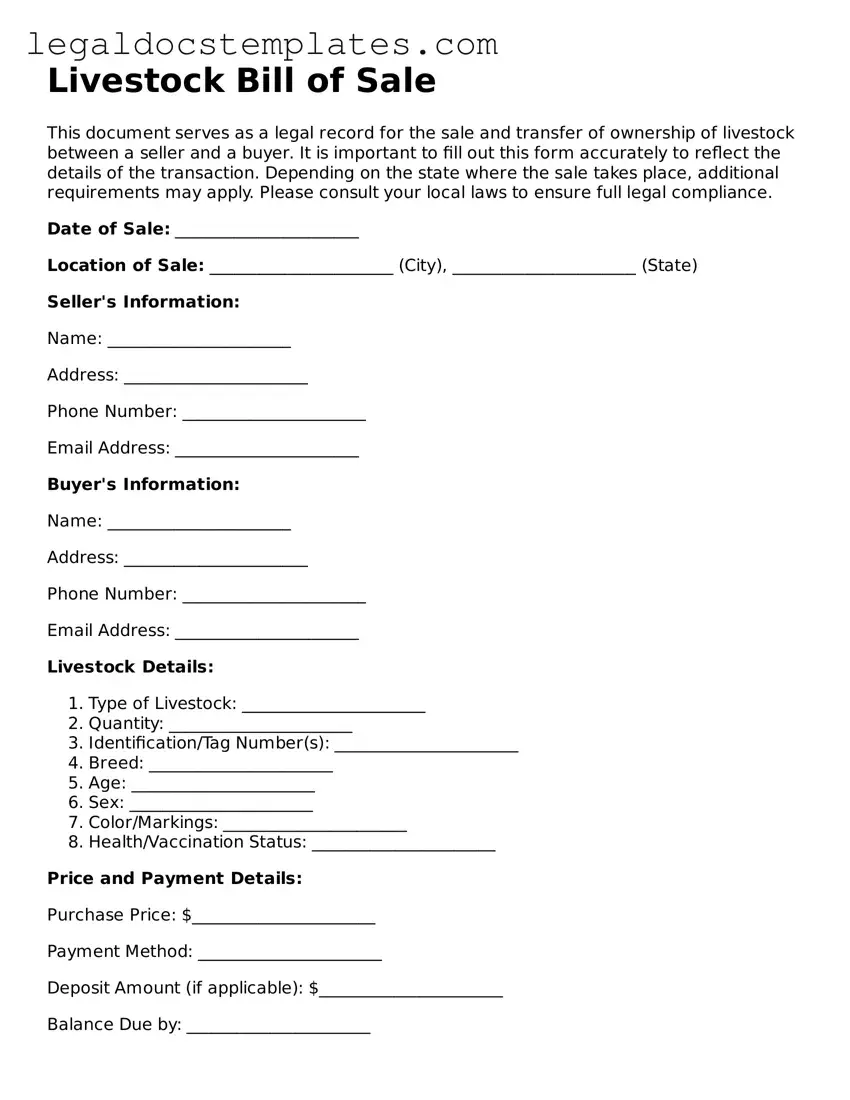The Vehicle Bill of Sale form shares a fundamental similarity with the Livestock Bill of Sale, both serving as a crucial proof of transaction between buyer and seller. The primary purpose of these documents is to record the sale and transfer of ownership - where the Livestock Bill of Sale covers animals, the Vehicle Bill of Sale does the same for automobiles. Each document outlines essential details such as the description of the item sold (livestock or vehicle), the sale price, and the particulars of the parties involved. This legal framework ensures that the transfer is recognized for registration, taxation, and liability purposes.
Another document closely related to the Livestock Bill of Sale is the Equipment Bill of Sale. This document is used to record transactions involving the sale of machinery or equipment. Similar to the Livestock Bill of Sale, it details the item’s description, the sale amount, and the identities of the buyer and seller. The Equipment Bill of Sale is crucial for businesses and individuals alike, providing a legal record that can be used for accounting purposes, securing financing, or resolving disputes regarding the ownership and condition of the equipment.
The Real Estate Purchase Agreement bears similarities to the Livestock Bill of Sale by serving as a legal record of the transfer of property; however, its scope involves real estate rather than movable property. It provides a detailed account of the transaction, recording the property’s location, the agreed-upon price, and terms of sale, similar to how the Livestock Bill of Sale logs the details of the livestock sold. Both documents are indispensable for ensuring the legal transfer of ownership and for the protection of both buyer and seller.
A General Bill of Sale is akin to the Livestock Bill of Sale, as it is used to document the sale of personal property items, ranging from furniture to electronics, between private parties. Like the Livestock Bill of Sale, it includes information about the item sold, the purchase price, and the parties involved. The General Bill of Sale is versatile, covering items not specifically included in more specialized bills of sale, offering a broad legal framework for private sales transactions.
The Warranty Deed, while primarily used in real estate transactions, shares a core similarity with the Livestock Bill of Sale in that it provides a guarantee about the item being transferred. The Warranty Deed guarantees the property is free from liens or claims, much like how a Livestock Bill of Sale can include guarantees about the health and status of the livestock. Both serve to protect the buyer’s interests and ensure the seller holds the right to sell the item in question.
The Promissory Note is akin to the Livestock Bill of Sale, albeit focusing on the aspect of financial obligation rather than the transfer of physical goods. It records the details of a loan's terms between two parties, specifying the repayment schedule, interest rate, and consequences of non-payment. Like the Livestock Bill of Sale, it is a binding document that ensures accountability and clarity in the transaction, providing a legal framework for recourse in case of disputes.
The Receipt of Sale is a simpler document compared to the Livestock Bill of Sale, but they share the fundamental purpose of acknowledging that a transaction has taken place. Both offer proof of purchase, detailing the item sold, the sale price, and the date of transaction. While a Receipt of Sale is usually less detailed and less formal, it serves a similar function in providing a record of the sale that can be used for personal records, warranties, and tax purposes.
The Transfer of Ownership form, although more generic, is similar to the Livestock Bill of Sale by facilitating the legal change of ownership of an item from one party to another. This form is used across various types of transactions, including those involving pets, vehicles, and even businesses, encapsulating the same essential information on the parties involved, the item being transferred, and any terms of the transfer. It ensures that the transaction is recognized by legal entities and helps in the resolution of any subsequent ownership disputes.
The Commercial Invoice, typically used in international trade, shares parallels with the Livestock Bill of Sale in documenting the details of a transaction. It specifies the products being sold, their value, and the terms of sale for customs and tax purposes. Although its primary function is for customs clearance, the commercial invoice's role in providing a detailed record of the transaction mirrors the Livestock Bill of Sale's function in domestic transactions involving animals.
Finally, the Gift Deed is an interesting counterpart to the Livestock Bill of Sale as it records the transfer of property without a purchase, focusing instead on items given as gifts. Despite the lack of a sale price, like the Livestock Bill of Sale, it includes details about the item transferred and the parties involved, ensuring that the gift is legally recognized and the ownership is accordingly transferred. This is particularly important in the context of tax implications and proving ownership should disputes arise.
